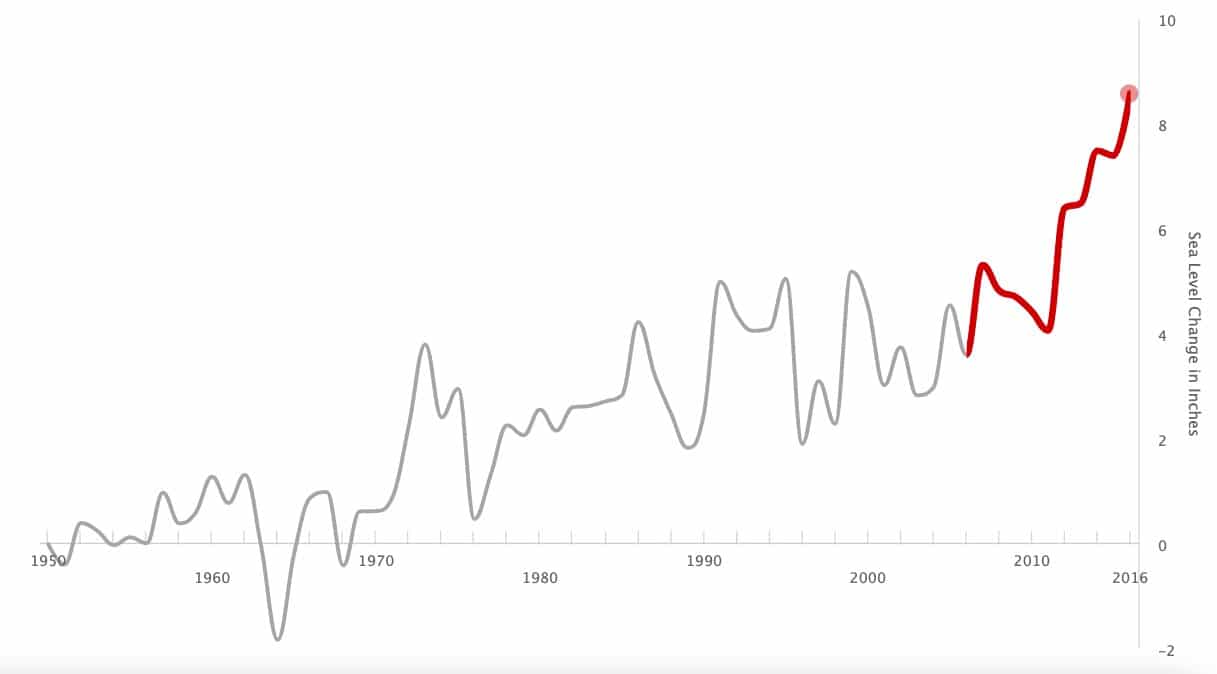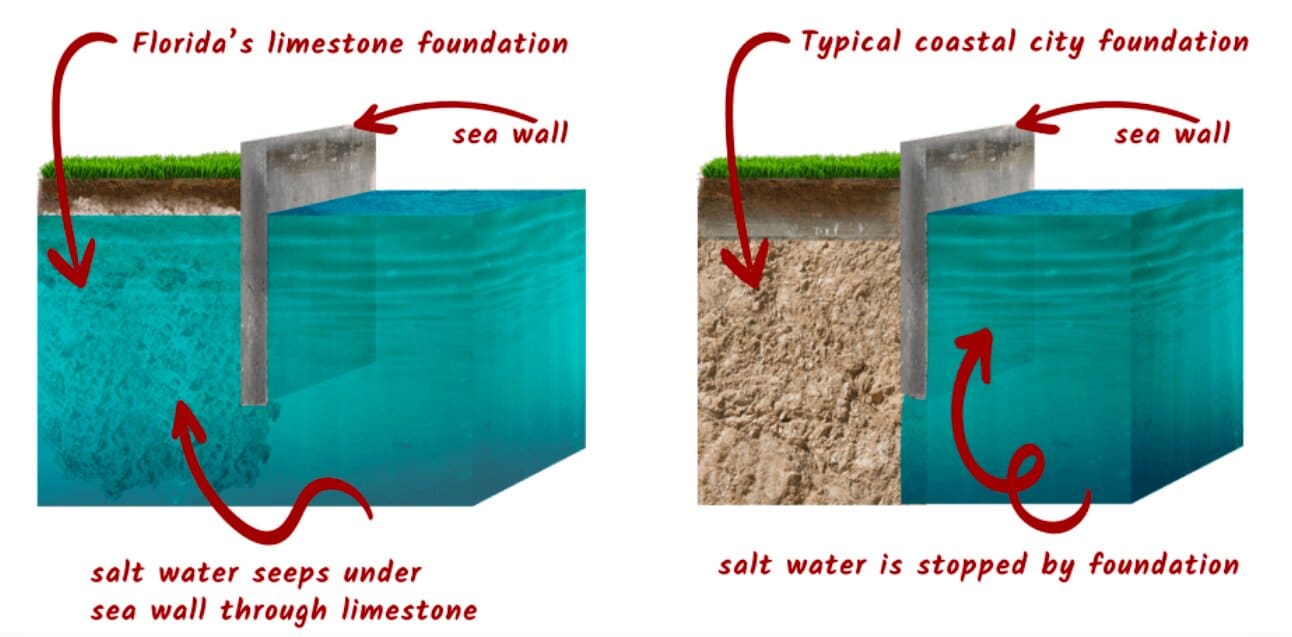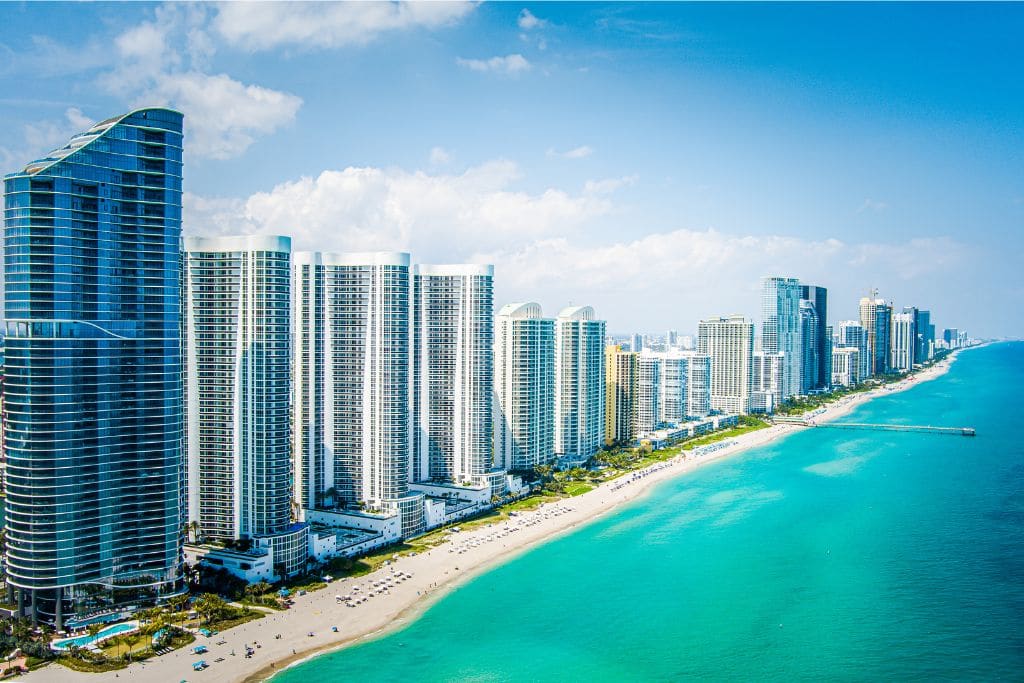Florida is more vulnerable to climate change compared to other parts of the US; the state is dealing with unprecedented flooding, water contamination, coastal erosion, and more frequent and destructive hurricanes, often at the same time. Florida also faces a higher risk of sea level rise from global warming. Though global sea levels have been increasing for decades, we are just starting to experience the real and potentially catastrophic effects of this phenomenon. We explore the causes and consequences of sea level rise in Florida, and how the local and federal governments are dealing with it.
—
Amid discussions of climate change, Florida’s rapidly rising sea levels have particularly gained widespread attention. Water levels have increased by eight inches (20 centimetres) compared to 1950 levels, averaging one inch (2.5 centimetres) every decade. However, increase rates have been accelerating and sea levels in the state are now rising by about one inch every three years.

Figure 1: Sea Level Measurement from Miami Area Tide Gauge, 1950-2016
Even if we were to drastically cut emissions, it is already too late to stop the near and mid-term impacts of this phenomenon. In Florida, experts predict that in the next 15 years, sea levels will rise by another six inches (15.2 centimetres), bringing irreversible consequences to its residents and ecosystem.
You might also like: Sea Level Rise Projections: Top 10 Cities at Risk of Flooding
What Is Causing Sea Level Rise in Florida?
There are three main reasons that explain the rapid rise in sea levels in Florida. First, ice sheets melting in Greenland and the Arctic are adding excess water into the ocean that could lead to more than 16 inches (40 centimetres) of increase at the current rate.
Another major factor is the constant slowing down of the Gulf Stream – a warm and swift Atlantic ocean current that heavily influences the climate of the east coast of North America from Florida to Newfoundland as well as the west coast of Europe. Climate scientists have recently detected warning signs of the collapse of Gulf Stream currents, which are already at their slowest in at least 1,600 years. Such an event could have catastrophic effects around the world, from disrupting rains in India, South America, and West Africa to increasing storms and lowered temperatures in Europe. As for North America, a slower Gulf Stream is already increasing sea levels and causing unusually high tides, so-called king tides. Under normal tide conditions, drainage systems channel excess rainwater from the streets and drain it back into the sea. When king tides occur, seawater can get pushed into these pipes and spill out into the streets, causing severe urban flooding. While these events are nothing new for Florida, they are now not only getting more frequent and longer but also significantly more powerful.
Finally, sea level is rapidly rising in Florida due to its geographical location. The US state sits on a bedrock of porous limestone. This sponge-like ground allows groundwater to easily flow through the holes from below, rising at the same rate as the ocean floor. This often undermines the effect of prevention mechanisms that the state has built in recent years. Sea walls, for example, are not able to protect the land from flooding, as water can easily flow under them.

Florida Is Paying a High Price for Rising Sea Levels
Current data suggests that as many as 3.5 million people in Florida are at risk of coastal flooding but at the current rate, an additional 1.1 million people will be threatened by 2050.
Indeed, rising sea levels in Florida have affected weather events such as hurricanes and rainfalls, making them not only more frequent but also much stronger. The changing climate also brought extended droughts and heatwaves, which impact water storage in the aquifer system.
Moreover, changes in sea levels, as well as coastal storms, are increasing the risk of flooding. Across the state, this phenomenon has increased by 352% since 2000. In Virginia Key – currently one of the most affected areas – the frequency of tidal flooding is expected to skyrocket in the coming decades, going from an annual average of 10 to as many as 55 days by 2050. Because groundwater levels are not high enough relative to the rising sea levels, when floods occur, saltwater can enter freshwater aquifers more easily, compromising sewage plants and water wells.
In recent years, Florida has also experienced unpredictable and inconsistent rainfall, along with more intense hurricanes. Just a few inches of sea level increase allows hurricanes to push more water onto land, even if they do not make landfall. One such example was the devastating Hurricane Irma, which has gone down in history as the most costly storm in the history of Florida, costing the state almost USD$50 billion in damages. A study found that a 15 inch increase in nearby sea levels – a scenario that is extremely likely to occur in 50 years’ time – would have resulted in a 150% increase in the number of homes impacted by Hurricane Irma’s storm surge. Thankfully, sea levels were not as high when the storm hit Florida in 2017. This however, should serve as an explicit warning of the exponentially higher impact that extreme weather events will take place in the future.
What is Florida Doing to Tackle Sea Level Rise?
According to a draft of Miami’s stormwater master plan, the city alone will have to spend at least USD$3.8 billion in the next four decades to keep the city dry from rising seas. Yet factors such as its limestone bedrock represent challenges that will be extremely costly, and sophisticated infrastructure will not be able to fully overcome.
For now, the plan is to make the flood-prone city more resilient to the 18 to 30 inches of sea level rise expected by 2060. This means, first and foremost, drastically increasing the number of stormwater pumps, which are needed to prevent water from swamping city streets and yards. To move such massive volumes of water around, the pipes under the city will need to be expanded to at least double their current sizes. The plan also comprises thousands of injection wells across the city, which will shoot the water captured by pipes deep underground. To lessen the burden on the pipe’s network, the city will invest in the construction of more parks and green areas to help absorb some of the rain and seawater during floods.
But Miami is not the only city in need of interventions. In 2021, Governor Ron DeSantis signed into law Senate Bill 1954, a comprehensive legislation to further strengthen the state’s resiliency efforts, securing over USD$640 million in federal investments to fund resilience projects across Florida’s most threatened areas, such as Pinellas County on the west coast and the Florida Keys archipelago located off the southern coast. This, combined with local funds, brings the state’s total budget to more than USD$1 billion.
You might also like: The Looming Water Shortage Crisis in Florida


















